Permaculture companion plants for Rose
| Image | Name | Data | Description | Actions |
|---|---|---|---|---|

|
Chives |
3-12
Full sun, Partial sun/shade
Moist
Light (sandy), Medium, Heavy (clay)
6.0-7.0
0.3
0.45
Perennial
Herbs
Medium
8-12inches
Seed - direct sow, Seed - transplant, Division
4-6 weeks before last frost
14-21 days
21°c (70°f)
antifungal, Dynamic accumulator, Ground cover, Fragrance
true
Flowers, Leaves, Root
Wild chives, Flowering onion
Schnittlauch
Alliaceae
Allium
Afghanistan, Alaska, Albania, Alberta, Altay, Austria, Baltic States, Belarus, British Columbia, Bulgaria, Buryatiya, Central European Rus, Chita, Colorado, Connecticut, Corse, Czechoslovakia, Denmark, East European Russia, Finland, France, Germany, Great Britain, Greece, Idaho, Iran, Iraq, Irkutsk, Italy, Japan, Kamchatka, Kazakhstan, Khabarovsk, Korea, Krasnoyarsk, Kuril Is., Labrador, Magadan, Maine, Manitoba, Massachusetts, Michigan, Minnesota, Mongolia, Montana, Netherlands, New Brunswick, New Hampshire, New Jersey, New York, North Caucasus, North European Russi, Northwest European R, Northwest Territorie, Norway, Nova Scotia, Nunavut, Ohio, Ontario, Oregon, Pakistan, Pennsylvania, Poland, Portugal, Primorye, Prince Edward I., Québec, Rhode I., Romania, Sakhalin, Saskatchewan, South European Russi, Spain, Sweden, Switzerland, Tadzhikistan, Transcaucasus, Turkey, Tuva, Ukraine, Vermont, Washington, West Himalaya, West Siberia, Wisconsin, Wyoming, Xinjiang, Yakutskiya, Yugoslavia, Yukon
Argentina South, Azores, Belgium, Comoros, Cuba, Dominican Republic, Falkland Is., Haiti, Illinois, Ireland, Jamaica, Maryland, Newfoundland, Seychelles, Trinidad-Tobago
https://en.wikipedia.org/wiki/Chives
https://pfaf.org/User/Plant.aspx?LatinName=Allium schoenoprasum
https://powo.science.kew.org/taxon/urn:lsid:ipni.org:names:528823-1
|
Chives (Allium schoenoprasum) are a bulb-forming herbaceous perennial plants that belong to the same family as onions, garlic, and leeks. They are native to Europe, Asia, and North America, and are commonly grown in gardens for their delicate onion flavor and attractive purple flowers. Chives are easy to grow and require little maintenance. They can be grown in pots or containers, or directly in the ground. The plants have thin, hollow leaves that grow in tight clumps and reach a height of around 12-20 inches (30-50 cm). The bulbs are slender, conical, 2–3 cm (3⁄4–1 1⁄4 in) long and 1 cm (1⁄2 in) broad, and grow in dense clusters from the roots. The scapes (or stems) are hollow and tubular, up to 50 cm (20 in) long and 2–3 mm (1⁄16–1⁄8 in) across, with a soft texture, although, prior to the emergence of a flower, they may appear stiffer than usual. The grass-like leaves, which are shorter than the scapes, are also hollow and tubular, or terete, (round in cross-section) which distinguishes it at a glance from garlic chives (Allium tuberosum). The flowers are pale purple, and star-shaped with six petals, 1–2 cm (1⁄2–3⁄4 in) wide, and produced in a dense inflorescence of 10-30 together; before opening, the inflorescence is surrounded by a papery bract. The seeds are produced in a small, three-valved capsule, maturing in summer. The herb flowers from April to May in the southern parts of its habitat zones and in June in the northern parts. Chives are often used as a seasoning in a variety of dishes, including soups, omelets, and dips. They can also be added to melted butter to make a simple but flavorful sauce for steamed vegetables. Chives are low in calories and a good source of vitamin C, making them a healthy addition to any diet. |
Show
Edit |
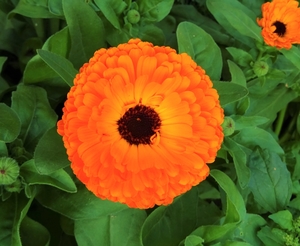
|
Pot marigold |
2-11
Full sun, Partial sun/shade
Moist
Light (sandy), Medium, Heavy (clay)
5.5-7.0
0.6
0.3
Annual
Medium
15cm
6-14 days
21°c (70°f)
60
Compost, Cosmetic, Dye, Essential Oil, Weather forecasting, Dynamic accumulator, Fragrance
Flowers, Leaves
Calendula, Common marigold, Scotch marigold, Ruddles
Ringelblume
Asteraceae or compositae
Spain
Afghanistan, Albania, Argentina Northeast, Argentina Northwest, Argentina South, Assam, Austria, Azores, Baleares, Baltic States, Belarus, Belgium, Bolivia, Borneo, British Columbia, Bulgaria, California, Canary Is., Central European Rus, Chatham Is., Chile Central, Chile North, Chile South, China North-Central, China South-Central, China Southeast, Colombia, Connecticut, Cook Is., Corse, Costa Rica, Cyprus, Czechoslovakia, East Aegean Is., East European Russia, East Himalaya, Ecuador, Ethiopia, France, Germany, Great Britain, Greece, Guatemala, Hainan, Honduras, Hungary, India, Iraq, Ireland, Italy, Jawa, Juan Fernández Is., Kazakhstan, Kriti, Krym, Lebanon-Syria, Lesser Sunda Is., Libya, Madeira, Maine, Malaya, Manchuria, Massachusetts, Mauritius, Mexico Southeast, Michigan, Morocco, Myanmar, Nepal, Netherlands, New Hampshire, New South Wales, New York, New Zealand North, New Zealand South, Newfoundland, North Caucasus, North European Russi, Northern Territory, Northwest European R, Norway, Nova Scotia, Ohio, Ontario, Pakistan, Paraguay, Pennsylvania, Peru, Philippines, Poland, Portugal, Primorye, Qinghai, Queensland, Québec, Romania, Sardegna, Sicilia, South Australia, South European Russi, Sulawesi, Sumatera, Sweden, Switzerland, Tadzhikistan, Taiwan, Tasmania, Tibet, Transcaucasus, Trinidad-Tobago, Turkey, Turkmenistan, Ukraine, Uruguay, Uzbekistan, Victoria, Vietnam, Washington, Western Australia, Wisconsin, Xinjiang, Yugoslavia
https://en.wikipedia.org/wiki/Calendula_officinalis
https://pfaf.org/User/Plant.aspx?LatinName=Calendula officinalis
https://powo.science.kew.org/taxon/urn:lsid:ipni.org:names:187894-1
4.6
Colouring, Tea
true
|
The pot marigold, also known as Calendula officinalis, is a flowering plant probably native to southwestern Asia, western Europe, and the Mediterranean region, however, its long cultivation history makes its precise origin unknown. It is a herbaceous annual plant that typically grows to be about 12-18 inches tall, with hairy stems and leaves. The leaves are lance-shaped, with a hairy surface, and the flowers can range in colour from white through yellow and orange to red and even pink. In terms of growing conditions, the pot marigold prefers well-drained soil and full sun, although it can tolerate partial shade. It is winter hardy, but may not flower as profusely in colder climates. To cultivate it successfully, a grower should plant pot marigold seeds directly in the ground after the last frost of the season. The pot marigold has a number of uses, both culinary and medicinal. The flowers are edible and can be used to add color and flavor to salads and other dishes. The petals can also be dried and used to make tea. In terms of medicinal uses, the plant has been used for centuries to treat a variety of ailments, including wounds, infections, and skin irritation. The pot marigold is also attractive to a variety of pollinators, making it a valuable plant for attracting beneficial insects to the garden. Overall, the pot marigold is a versatile and easy-to-grow plant that is well-suited to a variety of garden settings. ### Propagation - Direct sow Direct sow in spring when light frost is still possible. Can be sown until early summer for fall blooms. ### Propagation - Transplant Sow indoors in late winter, transplant outside when risk of heavy frost has passed. #### Links [Calendula @ West Coast Seeds](https://www.westcoastseeds.com/products/zeolights-organic) |
Show
Edit |

|
Garlic |
3-10
Perennial
Full sun
Dry, Moist
Light (sandy), Medium
0.6
Herbs
Flowers, Leaves, Root, Seed
Seed - direct sow
https://en.wikipedia.org/wiki/Garlic
Cultivated garlic
Alliaceae
Knoblauch
20cm
https://pfaf.org/User/Plant.aspx?LatinName=Allium sativum
6.5-7.0
Sting and itch relief from insect bites
Fibrous
Shallow
100-150
Allium
Iran, Kazakhstan, Kirgizstan, Tadzhikistan, Turkmenistan, Uzbekistan
Albania, Algeria, Amur, Austria, Baleares, Baltic States, Bangladesh, Belarus, Bulgaria, Cambodia, Canary Is., Central European Rus, China North-Central, China South-Central, China Southeast, Corse, Cuba, Czechoslovakia, Dominican Republic, East European Russia, Egypt, Ethiopia, France, Galápagos, Germany, Greece, Haiti, Hungary, Illinois, India, Iraq, Italy, Jamaica, Kentucky, Korea, Leeward Is., Libya, Mexico Central, Mexico Northwest, Mexico Southeast, Mexico Southwest, Morocco, New York, North European Russi, Northwest European R, Pakistan, Poland, Primorye, Puerto Rico, Romania, Sardegna, Seychelles, Sicilia, South European Russi, Spain, Switzerland, Tennessee, Thailand, Trinidad-Tobago, Tunisia, Turkey, Ukraine, Vermont, Wisconsin, Yugoslavia
Late autumn, Early spring
https://powo.science.kew.org/taxon/urn:lsid:ipni.org:names:528796-1
Adhesive, antifungal, Dynamic accumulator
true
|
Garlic (Allium sativum) is a bulbous perennial plant in the family Amaryllidaceae. It is native to central Asia and northeastern Iran, and has long been a staple in cuisines around the world. The plant has a distinctive appearance, with narrow, long leaves and a tall, hollow stem. The leaves are a pale green color and are attached to the stem in a spiral arrangement. The flowers are small and white, and are clustered in a spherical head at the top of the stem. Garlic plants can grow to a height of 30-150 cm (12-59 in), depending on the variety. They are relatively fast-growing plants, with the bulbs maturing in about seven months. Mulch for proper overwintering when planted in autumn. Garlic can be differentiated from other plants in the Allium genus by its distinctive flavor and aroma. It is also often distinguished by its long, narrow leaves and tall, hollow stem. Garlic prefers well-drained soil and full sun, and is typically grown from bulbs. To cultivate garlic successfully, growers should plant the bulbs in the fall, about 6-8 weeks before the first frost. The bulbs should be spaced about 10-15 cm (4-6 in) apart, with the pointed end facing up. After planting, the bulbs should be watered regularly and mulched to protect them from cold temperatures. Garlic is edible, with the bulbs and leaves being the most commonly eaten parts of the plant. The bulbs can be used fresh or cooked, and are often used as a seasoning in a wide variety of dishes. The leaves can be used fresh or cooked, and have a milder flavor than the bulbs. To harvest dig and do not pull out the bulbs. Let them dry in an airy, shady and dry spot e.g. by hanging them up. Once wrappers are dry, it can be stored at a dry place for several months. In addition to its culinary uses, garlic has a number of other uses. It is commonly used medicinally, as it has been shown to have antimicrobial and anti-inflammatory properties. It is also sometimes used as a natural insect repellent. In the garden, it can be used as a natural fertilizer, as it is believed to improve the soil and help deter pests. Garlic has value for wildlife, as it is attractive to a wide variety of pollinators, including bees, butterflies, and hummingbirds. It is also a food source for animals such as rabbits and deer. |
Show
Edit |
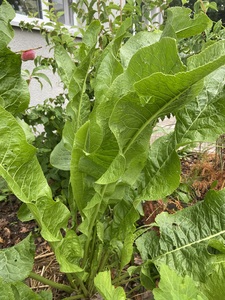
|
Horseradish |
4-9
Full sun, Partial sun/shade
Moist
Light (sandy), Medium, Heavy (clay)
5.5-7.0
Deciduous
0.7-1.5m
1
Perennial
Herbs
Fast
20cm (8″) / 40-50cm (16-20″)
Seed - transplant, Seed - direct sow, Division
2-4 weeks before last frost
8-12 weeks before last frost
At last frost date
7-25 days
7-23°c (45-75°f)
55
3 to 7 years
antifungal
true
Leaves, Root, Seed
Red cole, Cochlearia armoracia
Meerrettich
Mierik, Mierikswortel
Peberrod
Brassicaceae
Europe, South European Russi, Ukraine
Albania, Altay, Austria, Baltic States, Belarus, Belgium, British Columbia, Bulgaria, Buryatiya, California, Central European Rus, China North-Central, China Southeast, Colorado, Connecticut, Czechoslovakia, Denmark, East European Russia, Finland, France, Germany, Great Britain, Hungary, Idaho, Illinois, Indiana, Iowa, Ireland, Italy, Jamaica, Japan, Kamchatka, Kazakhstan, Kentucky, Kirgizstan, Korea, Krasnoyarsk, Maine, Manchuria, Manitoba, Marianas, Maryland, Massachusetts, Michigan, Minnesota, Missouri, Montana, Nebraska, Netherlands, New Brunswick, New Hampshire, New Jersey, New Mexico, New York, New Zealand North, New Zealand South, North Carolina, North Caucasus, North Dakota, North European Russi, Northwest European R, Norway, Nova Scotia, Ohio, Ontario, Oregon, Pennsylvania, Poland, Primorye, Prince Edward I., Québec, Rhode I., Romania, Sakhalin, Saskatchewan, Sicilia, South Dakota, Spain, Sweden, Switzerland, Tadzhikistan, Tennessee, Transcaucasus, Turkey, Turkey-in-Europe, Tuva, Utah, Uzbekistan, Vermont, Virginia, Washington, West Virginia, Wisconsin, Wyoming, Yugoslavia
True
https://en.wikipedia.org/wiki/Horseradish
https://pfaf.org/User/Plant.aspx?LatinName=Armoracia rusticana
https://powo.science.kew.org/taxon/urn:lsid:ipni.org:names:278747-1
Tap
60cm
8-12 weeks before last frost
True
Roots
Condiment
|
Horseradish (Armoracia rusticana) is a perennial plant native to southeastern Europe and western Asia. It is a member of the Brassicaceae family, which includes other plants such as mustard and cabbage. The plant has large, dark green leaves and a white, elongated root. It grows to about 1-1.5 meters tall and has small white flowers that bloom in the spring. Horseradish is often grown for its large, white, pungent root, which is used as a condiment. The root can grow quite large and can be up to 1.5 meters in length. It is typically harvested in the fall, after the plant has been growing for at least two years. Horseradish prefers well-draining soil and full sun, and can be grown successfully in a wide range of climates. To cultivate horseradish, a grower can plant the root in the spring and keep the soil consistently moist. Once the plant is established, it can be harvested by carefully digging up the root and removing the leaves. The root of the horseradish plant is edible and is typically grated and used as a condiment. It has a strong, pungent flavor that is often used to add a spicy kick to dishes. The root can be stored in the refrigerator for several weeks, or it can be preserved by pickling or canning. Horseradish has a number of uses beyond its use as a condiment. It is sometimes used medicinally to treat respiratory conditions, and the leaves can be used as a natural insect repellent. The plant can also be used as a natural fertilizer or as a natural deterrent to pests. It is not known to be particularly valuable to wildlife. ## Propagation While it is possible to grow from seed, the way more easy method is division. Divison can be done all year but best in spring. |
Show
Edit |
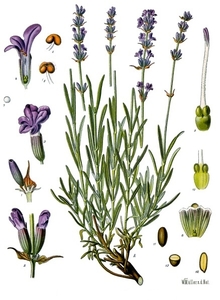
|
Lavender |
5-8
Full sun
Dry, Moist
Light (sandy), Medium, Heavy (clay)
Evergreen
1.2
0.6
Perennial
Shrubs
Slow
Companion, Essential Oil, Hedgerow, Fragrance
true
Flowers
True lavender
Lavendel
Lamiaceae or labiatae
France, Italy, Spain
Austria, Bulgaria, East Aegean Is., Germany, Krym, Marianas, New York, Tunisia, Venezuela, Vermont, West Himalaya
https://en.wikipedia.org/wiki/Lavandula_angustifolia
https://pfaf.org/User/Plant.aspx?LatinName=Lavandula angustifolia
https://powo.science.kew.org/taxon/urn:lsid:ipni.org:names:449008-1
True
No
Light
Condiment, Tea
|
Lavender, also known as Lavandula angustifolia, is a flowering plant native to the Mediterranean region. It is a small shrub with silvery-gray leaves and violet-blue flowers that bloom in the summer. The plant typically grows to a height of about 30-80 cm and has a strong, fragrant aroma. In terms of growing conditions, lavender prefers well-drained, sandy soil and full sun. It can be grown in pots or in the ground, and should be watered regularly but not overwatered. To cultivate lavender successfully, a grower should ensure that the plant receives plenty of sunlight and water, and should trim the plant regularly to promote healthy growth. Lavender has a number of uses, both culinary and medicinal. The flowers and leaves of the plant can be dried and used in a variety of dishes, such as lavender shortbread or lavender lemonade. The essential oil of lavender can also be used in aromatherapy and has a number of medicinal properties, including the ability to soothe anxiety and promote relaxation. In terms of its value for wildlife, lavender provides nectar for bees and other pollinators, and can be a valuable addition to a garden that is looking to support local wildlife. Overall, lavender is a versatile plant that is prized for its fragrant flowers and useful properties. |
Show
Edit |
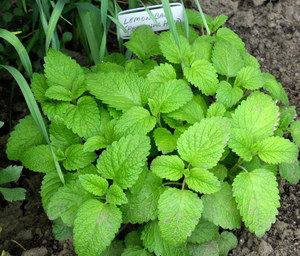
|
Lemon balm |
4-8
Full sun, Partial sun/shade
Dry, Moist
Light (sandy), Medium
0.7
Perennial
Herbs
Fast
45cm
true
Leaves
Balm, common balm, balm mit, bee balm, sweet balm
Zitronenmelisse
Lamiaceae or labiatae
Albania, Algeria, Baleares, Bulgaria, Corse, Cyprus, East Aegean Is., France, Greece, Iran, Iraq, Italy, Kirgizstan, Kriti, Lebanon-Syria, Morocco, North Caucasus, Palestine, Portugal, Sardegna, Sicilia, Spain, Tadzhikistan, Transcaucasus, Tunisia, Turkey, Turkey-in-Europe, Turkmenistan, Uzbekistan, Yugoslavia
Alabama, Argentina Northeast, Argentina Northwest, Argentina South, Arkansas, Austria, Azores, Belgium, British Columbia, California, Canary Is., Chile Central, Connecticut, Czechoslovakia, Delaware, Denmark, District of Columbia, Georgia, Germany, Great Britain, Hungary, Idaho, Illinois, Indiana, Ireland, Juan Fernández Is., Kansas, Kentucky, Krym, Louisiana, Madeira, Maine, Manitoba, Maryland, Massachusetts, Michigan, Missouri, Montana, Netherlands, New Jersey, New York, New Zealand North, New Zealand South, North Carolina, Ohio, Oklahoma, Ontario, Oregon, Pennsylvania, Poland, Québec, Rhode I., Romania, South Carolina, South European Russi, Sweden, Switzerland, Tasmania, Tennessee, Ukraine, Uruguay, Vermont, Virginia, Washington, West Siberia, West Virginia
https://en.wikipedia.org/wiki/Lemon_balm
https://pfaf.org/User/Plant.aspx?LatinName=Melissa officinalis
https://powo.science.kew.org/taxon/urn:lsid:ipni.org:names:450084-1
Weed potential
No
Light
Condiment, Tea
Essential Oil, Fragrance, Dynamic accumulator
|
Lemon balm (Melissa officinalis) is a perennial herb in the mint family. It is native to the Mediterranean region, but can now be found in many parts of the world. The plant has a bushy, upright habit and can grow up to 3 feet tall. It has oval-shaped leaves that are about 2-3 inches long and have a lemon scent when crushed. The leaves are a bright green color and are slightly serrated on the edges. The plant produces small, white or pale yellow flowers that bloom in the summer. Lemon balm prefers well-drained soil and full sun to partial shade. It is relatively easy to grow and can be propagated by dividing the root ball or by taking stem cuttings. It is important to give the plant enough space to grow, as it can spread rapidly. To prevent the plant from becoming invasive, it is a good idea to regularly deadhead the flowers and trim back the stems. Lemon balm can be used in cooking and is often added to salads or used as a garnish. The leaves can also be used to make tea or added to drinks and desserts for a lemony flavor. Lemon balm is also used in traditional medicine, as it is believed to have calming and soothing effects. In the garden, lemon balm can be used as a companion plant to repel pests and attract beneficial insects. The plant is also a good source of nectar for bees and other pollinators. Overall, lemon balm is a useful and versatile herb that can be enjoyed in the kitchen and the garden. |
Show
Edit |
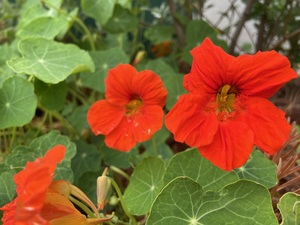
|
Nasturtium |
6-11
Full sun
Moist
Light (sandy), Medium
3.5
1
Annual, Perennial
Ground cover, Herbs
Fast
15cm
Seed - direct sow, Seed - transplant
1 week after last frost - late spring
2-4 weeks before last frost
2 weeks after last frost
7-12 days
12-18°C (55-65°F)
Pest control, oil, Fragrance
Flowers, Leaves, Seed, Seedpod
Oil, Condiment
Tropaeolum, Indian Cress
Große Kapuzinerkresse
Tropaeolaceae
Peru
Albania, Algeria, Amsterdam-St.Paul Is, Angola, Argentina Northeast, Ascension, Assam, Azores, Baleares, Bangladesh, Belgium, Bermuda, Bolivia, Brazil South, Brazil Southeast, Bulgaria, California, Cameroon, Canary Is., Cape Verde, Central European Rus, Chile Central, China South-Central, Colombia, Connecticut, Costa Rica, Cuba, Czechoslovakia, Dominican Republic, East Aegean Is., East Himalaya, Ecuador, El Salvador, Eritrea, Ethiopia, France, Free State, Great Britain, Greece, Guatemala, Haiti, Hawaii, Honduras, Jamaica, Juan Fernández Is., Korea, Kriti, Lebanon-Syria, Madeira, Massachusetts, Mauritius, Mexico Central, Mexico Northwest, Morocco, New Hampshire, New York, New Zealand North, New Zealand South, Norfolk Is., North European Russi, Oregon, Pennsylvania, Puerto Rico, Romania, Rwanda, Réunion, South European Russi, Spain, St.Helena, Tasmania, Tibet, Trinidad-Tobago, Tristan da Cunha, Tunisia, Uruguay, Vietnam, Zaïre
https://en.wikipedia.org/wiki/Tropaeolum_majus
https://pfaf.org/User/Plant.aspx?LatinName=Tropaeolum majus
https://powo.science.kew.org/taxon/urn:lsid:ipni.org:names:310974-2
true
|
Tropaeolum majus, commonly known as garden nasturtium, is a flowering plant that is native to South and Central America and can be grown annually as well as perennially. It belongs to the family Tropaeolaceae, which includes around 80 species of plants. T. majus is a popular garden plant, known for its bright, colorful flowers and attractive foliage. The flowers are typically yellow, orange, or red and have a distinctive, trumpet-like shape. The leaves are rounded and have a slightly waxy texture, and the plant produces long, trailing stems that can be used to create a cascading effect in hanging baskets or other containers. To grow T. majus, it is best to start the seeds directly in the ground or in pots after the last frost has passed. The plant prefers well-drained soil and full sun, but can also tolerate partial shade. It is important to water the plants regularly, but avoid overwatering, as this can cause the leaves to rot. T. majus can also be grown in containers and trained to climb trellises or other structures. In addition to its ornamental value, T. majus is also edible. The leaves, flowers, and seeds can be used in salads and other dishes, adding a slightly spicy, peppery flavor. The plant has also been used medicinally, as the leaves and seeds contain compounds with antibacterial and antioxidant properties. T. majus has been used to treat a variety of ailments, including respiratory infections and digestive disorders. It has also been used as a natural remedy for urinary tract infections and kidney stones. However, T. majus should be used with caution, as it can cause allergic reactions in some people. Additionally, T. majus can become invasive if allowed to spread, so gardeners should take care to keep it contained. #### Links [Nasturtium @ West Coast Seeds](https://www.westcoastseeds.com/products/jewel-mix ) |
Show
Edit |

|
Allium cepa |
3-9
Annual
Full sun
Moist
Light (sandy), Medium
0.6
Herbs
Flowers, Leaves, Root, Seed
Seed - direct sow, Seed - transplant
https://en.wikipedia.org/wiki/Onion
Garden onion
Alliaceae
Zwiebel
https://pfaf.org/User/Plant.aspx?LatinName=Allium cepa
50°f, 10°c
Seed indoors 6 weeks before transplanting in the garden
2-6 inches
6.0-7.0
Allium
Turkmenistan
Algeria, Argentina Northeast, Arkansas, Baltic States, Bangladesh, Belarus, Bulgaria, California, Cambodia, Canary Is., Central European Rus, China North-Central, China South-Central, China Southeast, Colombia, Cuba, Czechoslovakia, Dominican Republic, East Aegean Is., East European Russia, East Himalaya, Ecuador, Egypt, Ethiopia, Fiji, France, Galápagos, Guinea-Bissau, Haiti, Illinois, India, Iraq, Italy, Jamaica, Kansas, Kentucky, Kirgizstan, Korea, Krym, Libya, Louisiana, Madeira, Manchuria, Mauritania, Mexico Central, Mexico Gulf, Mexico Northeast, Mexico Southeast, Mexico Southwest, Minnesota, Montana, Morocco, New York, Niue, North European Russi, Northwest European R, Oregon, Pakistan, Puerto Rico, Seychelles, South European Russi, Spain, Tadzhikistan, Texas, Thailand, Tibet, Tonga, Trinidad-Tobago, Ukraine, Uzbekistan, Vermont, Washington, West Himalaya, West Siberia, Wisconsin, Xinjiang, Yugoslavia
Spring or fall
0.3
https://powo.science.kew.org/taxon/urn:lsid:ipni.org:names:527795-1
Cosmetic, Dye, Hair, Polish, Rust
true
|
Onion (Allium cepa) is a plant species in the family Amaryllidaceae. It is native to central Asia and is commonly grown as a vegetable in many parts of the world. Onions are biennial plants, meaning they typically have a two-year life cycle. In the first year, the onion forms a small, rounded bulb with thin, papery skin. In the second year, the onion will produce a tall stem with hollow, elongated leaves and a small, spherical flower head. Onions are typically grown for their bulbs, which are used as a food ingredient in many dishes. The bulbs can vary in size and shape, depending on the variety, but are generally spherical or oblong in shape and range in size from about 2-4 inches in diameter. Onions are commonly differentiated by their color, which can range from white to yellow to red. Onions prefer well-drained soil that is rich in organic matter. They should be planted in a sunny location and will benefit from regular watering, especially during dry periods. Onion bulbs can be harvested when they reach the desired size, typically after about 100-150 days of growth. To store onions, they should be dried and cured in a cool, dry place for about two weeks before being placed in a mesh bag or other breathable container. Onions are edible and are commonly used as a food ingredient in many dishes. The bulbs are the most commonly used part of the plant, but the leaves and stems can also be used in cooking. Onions have a pungent, spicy flavor and are often used to add flavor to soups, stews, and other dishes. Onions can be stored for several months if properly dried and cured. In addition to their use as a food ingredient, onions have also been used for their medicinal properties. They have been used to treat a variety of ailments, including coughs, colds, and respiratory infections. Onions are also sometimes used as a natural fertilizer, due to the high levels of sulfur and other nutrients they contain. Onions are not known to provide significant value to wildlife. They are not a preferred food source for most animals and do not provide any significant habitat value. However, some insects, such as the onion maggot, can be pests of onion crops. |
Show
Edit |

|
Parsley |
5-8
Biennial
Full sun, Partial sun/shade
Moist
Light (sandy), Medium, Heavy (clay)
0.6
Herbs
true
Leaves
https://en.wikipedia.org/wiki/Parsley
Medium
Apiaceae or umbelliferae
Petersilie
https://pfaf.org/User/Plant.aspx?LatinName=Petroselinum crispum
Algeria
Greece, Morocco, Yugoslavia
15cm
https://powo.science.kew.org/taxon/urn:lsid:ipni.org:names:60442790-2
Colouring, Tea
Essential Oil, Hair, Dynamic accumulator, Fragrance
|
Parsley is a herb native to the central and eastern Mediterranean region. It has bi-pinnate leaves and small, white or green flowers. The plant grows to a height of about 30 cm and has a fast growth rate. It can be differentiated from similar plants by its bi-pinnate leaves and small, white or green flowers. Parsley prefers well-drained soil and full sun to partial shade. To cultivate it successfully, a grower may need to water it regularly and protect it from frost. The plant is winter hardy and can withstand cold temperatures. Parsley is edible and its leaves and stems can be used in cooking. The edible parts can be stored after harvest by drying or freezing. Parsley has many uses, including medicinal and culinary. It has been used to treat a variety of ailments, such as indigestion and inflammation. In the kitchen, it can be used as a garnish or added to dishes for flavor. Parsley is also a good source of vitamins and minerals, such as vitamins A and C and iron. Parsley is valuable for wildlife as it provides nectar for pollinators. It is also a good source of food for some animals, such as rabbits and deer. #### Links [Parsley @ Wikipedia](https://en.wikipedia.org/wiki/Parsley) |
Show
Edit |
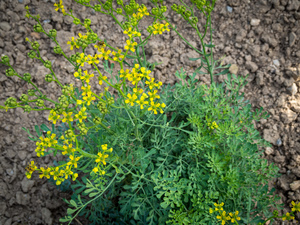
|
Ruta graveolens |
4-10
Full sun, Partial sun/shade
Dry, Moist
Light (sandy), Medium, Heavy (clay)
0.5
Shrubs
true
Leaves
https://en.wikipedia.org/wiki/Ruta_graveolens
Medium
Common rue, herb of grace, garden rue
Rutaceae
Weinraute
https://pfaf.org/User/Plant.aspx?LatinName=Ruta graveolens
Albania, Bulgaria, Krym, Turkey-in-Europe, Yugoslavia
Alberta, Algeria, Austria, Baleares, Belgium, California, Canary Is., Cape Provinces, Connecticut, Corse, Czechoslovakia, District of Columbia, East Aegean Is., Ecuador, France, Germany, Great Britain, Greece, Hungary, Illinois, Italy, Missouri, New Jersey, New York, North Carolina, Northern Provinces, Ontario, Pennsylvania, Québec, Rhode I., Romania, South European Russi, Spain, Switzerland, Texas, Ukraine, Vermont, Vietnam, Virginia, West Virginia, Wisconsin
https://powo.science.kew.org/taxon/urn:lsid:ipni.org:names:775099-1
Condiment, Rutin, Tea
Dye, Essential Oil, Strewing, Ground cover, Fragrance
|
Rue (Ruta graveolens) is a perennial herb native to the Balkan Peninsula. It is a small plant, growing to a height of about 30-60 cm (12-24 inches), with blue-green leaves and small, yellow flowers. The leaves have a strong, pungent aroma, and the plant is often used as a natural insect repellent. In terms of growing conditions, Rue prefers well-drained soil and full sun. It is drought-resistant and can be grown in a variety of climates, though it may not do well in extremely hot or humid conditions. To cultivate Rue successfully, a grower should plant it in a location that receives plenty of sunlight, and ensure that the soil is well-drained. Rue is not generally considered to be edible, and can cause skin irritation and other negative effects if ingested. However, it has been used medicinally in the past, and is sometimes used as a natural insect repellent or as a source of blue dye. It is also sometimes used in traditional witchcraft. In terms of its value to wildlife, Rue is a good source of nectar for bees and other pollinators, and its strong aroma may help to repel pests from nearby plants. It is not known to have any significant value as a food source for animals. |
Show
Edit |

|
Sage |
3-11
Annual, Perennial
Full sun
Dry, Moist
Light (sandy), Medium
Evergreen
0.6
Herbs
Flowers, Leaves
https://en.wikipedia.org/wiki/Salvia_officinalis
Medium
Kitchen sage, Small Leaf Sage, Garden Sage, Adacayi, Broadleaf sage, Ching-chieh, Common sage, Echter salbei, Mariyamiya, Sa er wei ya, Salbei, Salie, Salva, Salvia, Sauge commune, Sauge officinale, Sauge, Shalfey, True sage
Lamiaceae or Labiatae
Salbei
https://pfaf.org/User/Plant.aspx?LatinName=Salvia officinalis
Albania, France, Germany, Greece, Italy, Spain, Switzerland, Yugoslavia
Alabama, Algeria, Austria, Azores, Baleares, Bulgaria, California, Canary Is., Connecticut, Czechoslovakia, Georgia, Idaho, Kentucky, Korea, Libya, Maine, Maryland, Michigan, Morocco, New York, Ohio, Ontario, Oregon, Pennsylvania, Portugal, Québec, Rhode I., Romania, Sardegna, Sicilia, South European Russi, Tennessee, Transcaucasus, Tunisia, Turkey-in-Europe, Ukraine, Uruguay, Utah, Vermont, Virginia, Washington, West Virginia
0.75
https://powo.science.kew.org/taxon/urn:lsid:ipni.org:names:456833-1
Condiment, Tea
Compost, Essential Oil, Strewing, Teeth, Dynamic accumulator, Ground cover, Fragrance
true
|
Sage is a perennial herb native to the Mediterranean region. It has woody stems with gray-green leaves that are typically 2-4 inches long and have a soft, velvety texture. The flowers of sage are small and typically blue or purple, although they can also be white or pink. Sage grows to a height of about 2-3 feet and has a spreading habit. Sage prefers well-drained, sandy soil and full sun, and is drought-tolerant once established. It is winter hardy in most climates, but may need to be protected in very cold regions. To cultivate sage successfully, it is important to prune the plant regularly to promote new growth and prevent the plant from becoming woody. The leaves of sage are edible and have a strong, savory flavor. They can be used fresh or dried and are often used in dishes such as stuffings, sausages, and marinades. The leaves can also be stored for later use by drying them and storing them in an airtight container. Sage has a number of uses beyond its culinary value. It has traditionally been used for its medicinal properties, and is said to have antibacterial and anti-inflammatory effects. It is also often used as a fertility herb and is said to promote lactation in nursing mothers. Sage can also be used as a natural insect repellent and as a mulch to suppress weeds. Sage is valued by wildlife for its nectar, which attracts bees and other pollinators. It is also an important host plant for the larvae of several species of butterflies and moths. In addition, the leaves of sage can be used as a natural insecticide to control aphids and other garden pests. In humid zones above 9 it might be only possible to grow as an annual. |
Show
Edit |
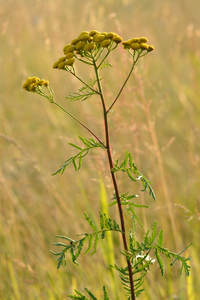
|
Tansy |
3-8
Full sun
Dry, Moist
Light (sandy), Medium, Heavy (clay)
1.0
0.5
Perennial
Herbs
Fast
true
Flowers, Leaves
Common tansy, golden buttons, curly leaf tansy
Rainfarn
Asteraceae or compositae
Albania, Altay, Amur, Austria, Baltic States, Belarus, Belgium, Bulgaria, Buryatiya, Central European Rus, Chita, Corse, Czechoslovakia, Denmark, East European Russia, Finland, France, Germany, Great Britain, Greece, Hungary, Inner Mongolia, Irkutsk, Italy, Japan, Kamchatka, Kazakhstan, Khabarovsk, Kirgizstan, Korea, Krasnoyarsk, Krym, Kuril Is., Magadan, Manchuria, Mongolia, Netherlands, North Caucasus, North European Russi, Northwest European R, Norway, Poland, Portugal, Primorye, Romania, Sakhalin, Sicilia, South European Russi, Spain, Sweden, Switzerland, Transcaucasus, Turkey, Turkey-in-Europe, Tuva, Ukraine, West Siberia, Xinjiang, Yakutskiya, Yugoslavia
Alaska, Alberta, Arizona, Arkansas, Bolivia, Brazil North, Brazil Northeast, Brazil South, Brazil Southeast, Brazil West-Central, British Columbia, California, Colombia, Colorado, Connecticut, Cook Is., Ecuador, Føroyar, Georgia, Iceland, Idaho, Illinois, Indiana, Iowa, Ireland, Kansas, Kentucky, Labrador, Louisiana, Maine, Manitoba, Maryland, Massachusetts, Mauritius, Michigan, Minnesota, Missouri, Montana, Nebraska, Nevada, New Brunswick, New Hampshire, New Jersey, New Mexico, New South Wales, New York, Newfoundland, North Carolina, North Dakota, Northwest Territorie, Nova Scotia, Ohio, Oklahoma, Ontario, Oregon, Panamá, Paraguay, Pennsylvania, Peru, Prince Edward I., Queensland, Québec, Rhode I., Réunion, Saskatchewan, South Australia, South Dakota, Tasmania, Tennessee, Trinidad-Tobago, Tubuai Is., Uruguay, Utah, Venezuela, Vermont, Victoria, Virginia, Washington, West Virginia, Wisconsin, Wyoming
https://en.wikipedia.org/wiki/Tansy
https://pfaf.org/User/Plant.aspx?LatinName=Tanacetum vulgare
https://powo.science.kew.org/taxon/urn:lsid:ipni.org:names:252568-1
0.2
Weed potential
Condiment, Tea
Compost, Dye, Essential Oil, Pest control, Strewing, Dynamic accumulator, Fragrance
|
Show
Edit |
|
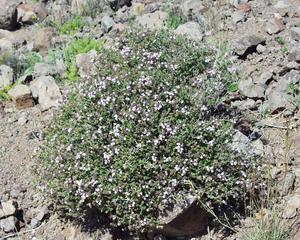
|
Thyme |
5-11
Perennial
Full sun
Dry, Moist
Light (sandy), Medium
Evergreen
0.1-0.3m
Herbs
true
Flowers, Leaves, Shoots
https://en.wikipedia.org/wiki/Thymus_vulgaris
Medium
Garden thyme, Wild Thyme, Samon-phyu, Timo, Tomillo, Thym, Common thyme, German thyme, Thyme
Lamiaceae or Labiatae
Thymian
https://pfaf.org/User/Plant.aspx?LatinName=Thymus vulgaris
Baleares, France, Italy, Spain
Algeria, Belgium, Cuba, Czechoslovakia, Dominican Republic, Haiti, Leeward Is., New Zealand South, Puerto Rico, Switzerland
0.3
https://powo.science.kew.org/taxon/urn:lsid:ipni.org:names:461765-1
Condiment, Tea
Deodorant, Disinfectant, Essential Oil, antifungal, Fragrance, Dynamic accumulator, Ground cover
|
Thyme (Thymus vulgaris) is a perennial herb that is native to the Mediterranean region. It has small, grey-green leaves and tiny, pink or purple flowers. The stems are woody and the plant grows to be about 30 cm tall. Thyme prefers well-drained, sandy soil and full sun. It is a low-maintenance plant and can be grown easily in a garden or in containers. To cultivate it successfully, it is important to water it regularly, especially during dry periods, and to trim the plant regularly to promote new growth. Thyme is edible and both the leaves and flowers can be used in cooking. They can be dried or frozen for long-term storage. The leaves have a strong, pungent flavor and are often used in meat and vegetable dishes, as well as in teas and other beverages. In addition to its culinary uses, thyme also has several medicinal properties. It has been used to treat respiratory conditions, such as bronchitis and asthma, and is also believed to have antibacterial and antifungal properties. It can also be used as a natural insect repellent. Thyme is an attractive plant that is valuable for wildlife. It is a good source of nectar for bees and other pollinators. It is also an important food plant for the caterpillars of some butterfly species. Overall, thyme is a versatile and useful herb that can be grown easily in a variety of conditions. Its flavorful leaves and attractive flowers make it a valuable addition to any garden or farm. |
Show
Edit |
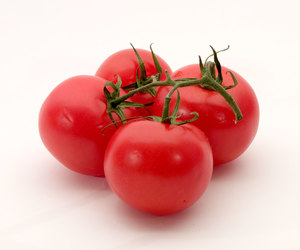
|
Tomato |
10-12
Annual, Perennial
Full sun
Moist
Light (sandy), Medium, Heavy (clay)
2.0
True
Fruit, Seed
https://en.wikipedia.org/wiki/Tomato
Fast
Garden tomato, Dumádu, Garden tomato, Love apple, Lycopersicum esculentum, Tomate, Tomato, Tomato extract containing lycopene, Tomato|thakkali, Tumatis, Lycopersicon esculentum
Solanaceae
Tomate
Oil
https://pfaf.org/User/Plant.aspx?LatinName=Solanum lycopersicum, https://pfaf.org/User/Plant.aspx?LatinName=Lycopersicon esculentum
Start seeds indoors 5-6 weeks before last frost
In containers or in rows in beds around last frost date
6.2-6.8
70-80°f
Peru
Alabama, Alaska, Andaman Is., Angola, Arizona, Arkansas, Assam, Austria, Azores, Bahamas, Bangladesh, Belarus, Benin, Bolivia, British Columbia, Bulgaria, Burkina, California, Cambodia, Cameroon, Canary Is., Cape Verde, Caroline Is., Central African Repu, Chagos Archipelago, Chatham Is., Christmas I., Colombia, Comoros, Connecticut, Cook Is., Costa Rica, Cuba, Cyprus, Czechoslovakia, Delaware, Dominican Republic, East Aegean Is., East European Russia, East Himalaya, Ecuador, Fiji, Florida, Galápagos, Georgia, Gilbert Is., Gulf of Guinea Is., Haiti, Hawaii, Illinois, India, Indiana, Iowa, Ivory Coast, Jawa, Kansas, Kazakhstan, Kentucky, Korea, Laccadive Is., Laos, Leeward Is., Line Is., Louisiana, Madagascar, Madeira, Maine, Malawi, Mali, Marianas, Marquesas, Marshall Is., Maryland, Massachusetts, Mauritania, Mauritius, Michigan, Mississippi, Missouri, Montana, Mozambique, Myanmar, Namibia, Nansei-shoto, Nauru, Nebraska, Nepal, Nevada, New Brunswick, New Caledonia, New Hampshire, New York, New Zealand North, Nicaragua, Nicobar Is., Niue, North Carolina, North Dakota, Nova Scotia, Ogasawara-shoto, Ohio, Ontario, Oregon, Pakistan, Panamá, Pennsylvania, Philippines, Pitcairn Is., Puerto Rico, Québec, Rhode I., Réunion, Saskatchewan, Selvagens, Society Is., South Carolina, South European Russi, Tadzhikistan, Taiwan, Tennessee, Texas, Trinidad-Tobago, Tuamotu, Tubuai Is., Turkey, Turkmenistan, Tuvalu, Utah, Uzbekistan, Venezuela, Vermont, Vietnam, Virginia, Wake I., Wisconsin, Zambia, Zaïre, Zimbabwe
1.00
https://powo.science.kew.org/taxon/urn:lsid:ipni.org:names:316947-2
|
The tomato is a flowering plant native to South America. It is a member of the nightshade family and closely related to the potato. The tomato plant typically grows to a height of 1-3 meters and has a weak, hairy stem. The leaves are arranged alternately on the stem and are typically dark green in color. The plant produces small yellow or white flowers, which develop into the fruit we know as tomatoes. The fruit itself is typically red, but can also be yellow, orange, green, or purple. Indeterminate tomato plants are perennials in their native habitat, but are cultivated as annuals. Determinate, or bush, plants are annuals that stop growing at a certain height and produce a crop all at once. Tomatoes prefer warm, sunny growing conditions and well-drained, humus-rich soil. They can be grown in a variety of soil types, but perform best in soil with a pH between 6 and 6.8. In order to cultivate tomatoes successfully, growers may need to provide support for the plant (such as a stake or cage) to prevent the fruit from weighing down the stem, and may also need to water and fertilize the plant regularly. Tomatoes are generally considered to be frost-sensitive, so in areas with cold winters they may need to be grown in a greenhouse or indoors. There are a great number of cultivars. The edible parts of the tomato plant are the fruit and the leaves. The fruit can be eaten raw or cooked, and is commonly used in a variety of dishes, such as salads, sandwiches, and pasta. The leaves, although not commonly eaten, are also edible and have a slightly bitter taste. After harvest, tomatoes can be stored at room temperature, in a cool place, or in the refrigerator. |
Show
Edit |
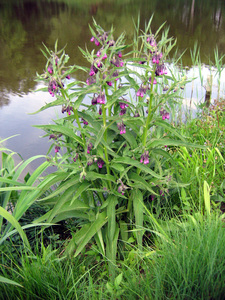
|
Comfrey |
3-9
Perennial
Full sun, Partial sun/shade
Moist
Light (sandy), Medium, Heavy (clay)
1.2
Herbs
true
Leaves, Shoots
https://en.wikipedia.org/wiki/Symphytum_officinale
Fast
Common comfrey, Comfrey, Symphytum
Boraginaceae
https://pfaf.org/User/Plant.aspx?LatinName=Symphytum officinale
Gewone smeerwortel
Lægekulsukker
Altay, Austria, Belarus, Belgium, Bulgaria, Central European Rus, Czechoslovakia, East European Russia, France, Germany, Great Britain, Hungary, Italy, Kazakhstan, Krym, Netherlands, North Caucasus, Northwest European R, Poland, Romania, Sardegna, Sicilia, South European Russi, Spain, Switzerland, Turkey, Turkey-in-Europe, Ukraine, West Siberia, Yugoslavia
Alberta, Argentina Northeast, Arkansas, Baltic States, Brazil West-Central, British Columbia, California, China North-Central, China Southeast, Chita, Colorado, Connecticut, Delaware, Denmark, District of Columbia, Dominican Republic, Finland, Georgia, Haiti, Idaho, Illinois, Indiana, Ireland, Kentucky, Korea, Maine, Manchuria, Manitoba, Maryland, Massachusetts, Michigan, Minnesota, Missouri, Montana, New Brunswick, New Hampshire, New Jersey, New Mexico, New York, Newfoundland, North Carolina, North European Russi, Norway, Nova Scotia, Ohio, Ontario, Oregon, Pennsylvania, Primorye, Québec, Rhode I., Saskatchewan, Sweden, Taiwan, Tasmania, Utah, Vermont, Vietnam, Virginia, Washington, West Virginia, Wisconsin, Wyoming, Xinjiang
Beinwell, Wallwurz, Beinwurz
60cm
https://powo.science.kew.org/taxon/urn:lsid:ipni.org:names:120815-1
Gum, Tea
Biomass, Compost, Gum, Dynamic accumulator
|
Comfrey (Symphytum officinale) is a perennial plant that is native to Europe and Asia. It belongs to the family Boraginaceae, which includes around 300 species of plants. Comfrey is a popular garden plant, known for its large, hairy leaves and bell-shaped, white or purple flowers. The plant has a sprawling growth habit and can reach a height of up to 3-4 feet. The leaves are large, oval-shaped, and covered in fine hairs, and the flowers are clustered in elongated spikes at the ends of the stems. To grow comfrey successfully, it is important to choose a location with well-drained, fertile soil and full sun or partial shade. The plant is tolerant of a wide range of soil conditions, but prefers moist, slightly acidic soil. Comfrey can also be grown in containers, and will benefit from regular watering and fertilization. The plant is relatively easy to grow and requires little maintenance, but can be susceptible to pests and diseases, such as slugs and fungal infections. Comfrey is not edible, and the leaves and roots of the plant contain toxic compounds that can cause irritation and allergic reactions in some people. However, the plant has a number of other uses, including medicinal and horticultural applications. The leaves and roots of the plant are high in nutrients, and are often used as a natural fertilizer for plants. The leaves can also be used to make a medicinal tea, and have been used to treat a variety of ailments, including wounds, bruises, and respiratory disorders. Comfrey is also a valuable food source for many types of wildlife, including bees, butterflies, and other pollinators. The flowers attract a wide range of insects, and the leaves and roots are eaten by animals such as rabbits and deer. The plant can spread rapidly and is considered invasive in some areas. |
Show
Edit |
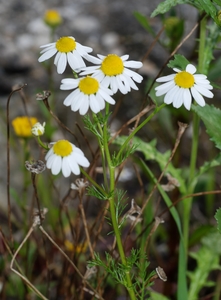
|
Chamomile |
5-9
Full sun
Dry, Moist
Light (sandy), Medium, Heavy (clay)
0.5
0.05
Annual
Herbs
at last frost date
1 week
Matricaria recutita - L., German chamomile, wild chamomile
Kamille
Asteraceae or Compositae
Afghanistan, Albania, Algeria, Altay, Austria, Azores, Belarus, Belgium, Bulgaria, Buryatiya, Canary Is., Central European Rus, China North-Central, China South-Central, China Southeast, Cyprus, Czechoslovakia, Denmark, East Aegean Is., East European Russia, Egypt, Finland, France, Germany, Greece, Hungary, India, Iran, Iraq, Irkutsk, Italy, Kazakhstan, Kirgizstan, Korea, Krasnoyarsk, Kriti, Krym, Lebanon-Syria, Manchuria, Mongolia, Morocco, Myanmar, Netherlands, North Caucasus, Northwest European R, Norway, Pakistan, Palestine, Portugal, Romania, Sardegna, Sicilia, Sinai, South European Russi, Spain, Sweden, Switzerland, Tadzhikistan, Transcaucasus, Turkey, Turkey-in-Europe, Tuva, Ukraine, Uzbekistan, Vietnam, West Himalaya, West Siberia, Xinjiang, Yakutskiya, Yugoslavia
Alabama, Alberta, Arizona, Arkansas, Baleares, Baltic States, Bolivia, British Columbia, California, Colombia, Connecticut, Corse, Costa Rica, Cuba, District of Columbia, Dominican Republic, Ecuador, El Salvador, Ethiopia, Great Britain, Greenland, Guatemala, Gulf States, Honduras, Illinois, Indiana, Iowa, Ireland, Jawa, Juan Fernández Is., Kansas, Kentucky, Magadan, Maine, Mali, Manitoba, Maryland, Massachusetts, Mexico Southeast, Michigan, Minnesota, Mississippi, Missouri, New Jersey, New South Wales, New York, Newfoundland, Nicaragua, North Dakota, North European Russi, Nova Scotia, Ohio, Ontario, Oregon, Paraguay, Pennsylvania, Peru, Poland, Primorye, Québec, Rhode I., Saskatchewan, South Australia, Tennessee, Texas, Tunisia, Uruguay, Utah, Vermont, Virginia, Washington, Wisconsin
https://en.wikipedia.org/wiki/Matricaria_chamomilla
https://powo.science.kew.org/taxon/urn:lsid:ipni.org:names:154715-2
Direct sow in autumn or shortly before latest date of frost
Start seeds indoors 6-8 weeks before last frost date
|
Chamomile is a plant native to Europe, North Africa, and Western Asia. It has a small, daisy-like flower with white petals and a yellow center. The leaves are thin and feathery, and the stem is thin and wiry. Chamomile grows to be about 12-24 inches tall and spreads to about 16-20 inches wide. It grows quickly, producing flowers within a few weeks of germination. Chamomile prefers well-drained soil and full sun to partial shade. It is a hardy plant and can tolerate drought and frost. To cultivate chamomile successfully, it is important to keep the soil moist and well-watered, especially during hot weather. Needs light to germinate. The flowers and leaves of chamomile are edible and can be used in a variety of dishes, including teas and salads. The flowers can also be dried and stored for later use. Chamomile has a number of medicinal properties and has been used to treat a variety of conditions, including anxiety, insomnia, and digestive issues. It is also believed to have anti-inflammatory and antimicrobial properties. In addition to its medicinal uses, chamomile can also be used as a ground cover or as a companion plant in gardens. It can help to repel pests and improve the health of nearby plants. Chamomile is also valued by bees and other pollinators, making it an important plant for maintaining biodiversity in gardens and agricultural areas. #### Links [Chamomile @ Plants For A Future](https://pfaf.org/user/Plant.aspx?LatinName=Matricaria recutita) |
Show
Edit |